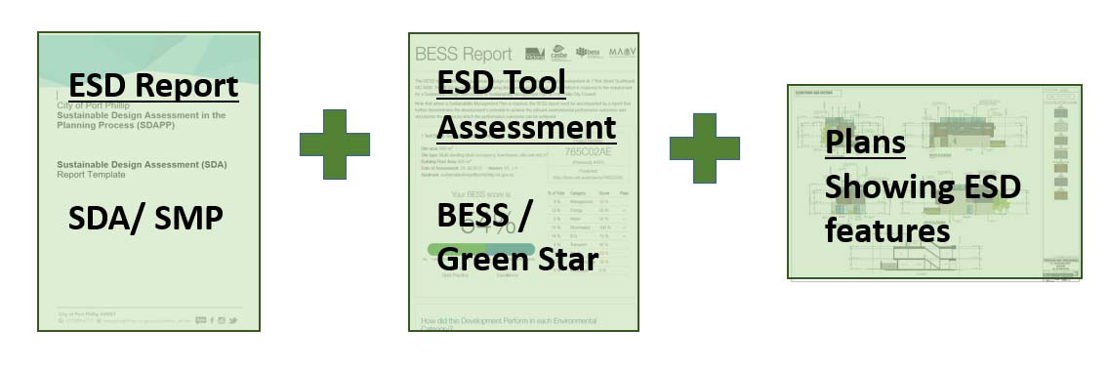Sustainable design
Environmentally Sustainable Design (ESD) overview
Every building provides an opportunity to improve and reduce impacts on the natural environment. Our Environmentally Sustainable Development (ESD) Strategy 2024 includes standards for both council-led development and private development.
The built environment contributes significantly to global greenhouse gas emissions and consumption of resources. The Port Phillip Planning Scheme requires development to incorporate environmentally sustainable design (ESD) principles, which include incorporation of sustainable building practices and Water Sensitive Urban Design (WSUD), to reduce these environmental impacts.
Developments with good ESD credentials both improve occupant comfort and reduce building running costs.
Steps to follow
- Integrate all relevant ESD features into the design
- Request a pre-application meeting with a Planner and council’s ESD Advisor
- Prepare supporting ESD reports
- Demonstrate delivery features with an As-Built report when construction concludes
What to submit
To ensure your planning application demonstrates environmental best practice;
- Ensure all ESD and WSUD features are clearly drawn and noted on the architectural plans
- Submit a supporting ESD and WSUD report
- Include a relevant tool assessment to quantify the development’s environmental credentials
Meaning of terms
Environmentally Sustainable Design (ESD) report – This contains details as to how the development addresses key ESD considerations. Usually called a Sustainable Design Assessment (SDA) or a Sustainability Management Plan (SMP).
Water Sensitive Urban Design (WSUD) report – This contains details as to how the development addresses WSUD stormwater harvesting and re-use. The objective being to reduce stormwater volume entering the drainage system and ultimately Port Philip Bay.
BESS – Built Environment Sustainability Scorecard –The Built Environment Sustainability Scorecard (BESS) is an online ESD assessment tool purpose-built for the planning application stage. It is suitable for almost all development types including single dwellings, dwelling extensions, multi-dwellings, non-residential and mixed use. A BESS score of 50 per cent indicates a 'Pass', while a score of 70 per cent or greater indicates 'Excellence'.
Blue Factor (Previously STORM) – Blue Factor assesses stormwater quality outcomes for small to medium-scale developments, as part of a WSUD Response. It's available online for free.
As-Built Report – A report containing evidence that ESD and WSUD features have been correctly installed on-site during the build. Please refer to these sample templates, ESD As-Built Report Template and WSUD As-Built Report Template.

Water sensitive urban design
What to submit
- Stormwater catchment plan
- Blue Factor / MUSIC report
- Maintenance manual for rainwater tank/ raingarden/ porous paving as applicable
- Connection details of any rainwater tank for stormwater re-use
- A stormwater site management plan – Refer to “Keeping our Stormwater Clean – A Builder’s Guide”
The development plans should also reflect the water sensitive urban design measures as per the stormwater catchment plan. For example, if a 2000L rainwater tank is to be connected to toilets for stormwater reuse, and located near the western boundary, this should be consistent on ground floor plan as well.
More detailed information about how to provide a good WSUD response can be found in this Compliance Guidelines for Stormwater Management document.
Key ESD considerations
Here is a summary of the current ESD Best Practice Standards.
The following links to online Sustainable Design Fact Sheets provide an overview of key ESD considerations:
- Operational Energy
- Embodied Carbon
- Integrated Water Management
- Indoor Environment Quality
- Urban Ecology
- Transport
- Waste & Resource Recovery
- Innovation
Upcoming changes to ESD policy – Elevated ESD Targets Planning Scheme Amendment
The City of Port Phillip is seeking an elevation of ESD targets, whereby the proposed ESD policy elevates ESD outcomes by introducing additional design standards, which include, but not limited to:
- Achieving net zero emissions development
- Reducing embodied emissions of materials
- Increasing the importance of vegetation
The proposed standards can be viewed online.
Case studies
Port Phillip’s neighbourhoods are home to many excellent best-practice examples of developments that successfully integrate ESD features to enhance their liveability, reduce running costs and lessen their environmental impacts.
Whether you live in an apartment or a house, are renting or own the property, there are changes you can make to ensure that your home is more resilient to climate change impacts, such as flood and heatwaves.
Port Phillip is a member of the Council Alliance for a Sustainable Built Environment (CASBE). CASBE member councils collectively work towards improving the sustainability of the built environment through the planning process. Here are some examples of how this translates to exemplary built form outcomes – industry case studies (CASBE).
Sustainable design in Fishermans Bend
Development in the Fishermans Bend Urban Renewal Area (FBURA) is subject to specific ESD requirements, as specified in Schedule 1 to the Capital City Zone of the Port Phillip Planning Scheme. These are:
- Achieve a certified Green Star rating using the Green Star Buildings Rating Tool. An overview is available here – Fishermans Bend Green Star Buildings Summary
- Rainwater tanks that capture all stormwater run-off, sized at 0.5m3 per 10m2 of roof area.
- Rainwater tanks connected to all non-potable water uses.
- Provision of recycled water supply via third pipe for all non-potable water uses.
Integrated water management case studies provided below demonstrate examples of how to respond to the specific ESD requirements in FBURA, for typical development typologies.
Interested in installing solar panels, home batteries, hot water systems or reverse cycle heating and air conditioners?
Our Council-backed, trusted and complementary Solar Savers program is here to help.
To find out more, call Solar Savers on 1300 548 598 or visit the Solar Savers website to register for more information.
Contact us
Our Planning team is here to help.
Send us a message on My Port Phillip.
Phone: 03 9209 6424
Email: Planhelp@portphillip.vic.gov.au
In-person: visit the Planning and Building Counter at St Kilda Town Hall during opening hours (8.30 am to 5 pm, Monday to Friday)